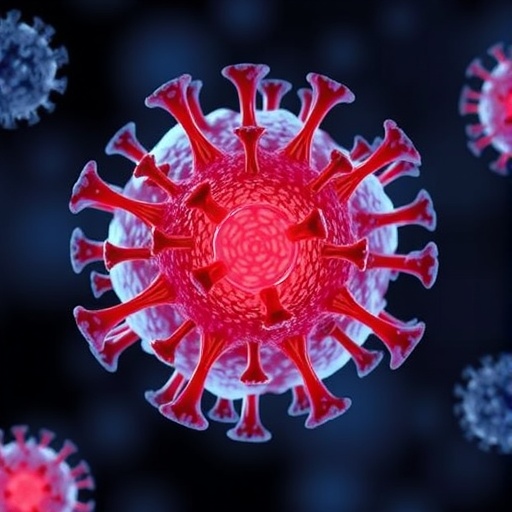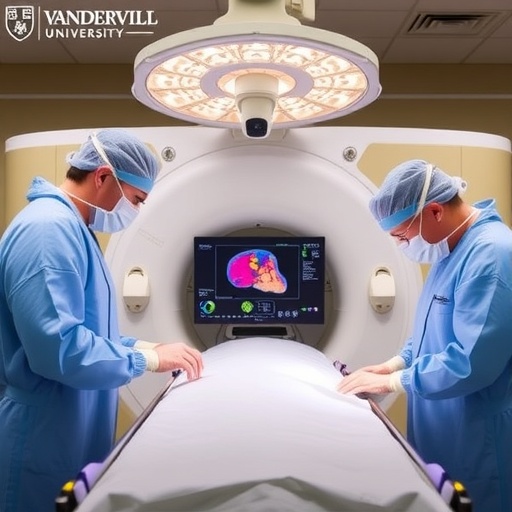
Human cytomegalovirus (HCMV), a pervasive member of the Herpesviridae family, continues to pose a significant challenge to global health due to its capacity to inflict severe congenital disabilities and life-threatening complications, especially among immunocompromised individuals. Despite decades of research, efforts to develop an effective vaccine have met with limited success, largely owing to the virus’s complex mechanisms of cellular entry and immune evasion. Recent breakthrough research has illuminated a previously unrecognized viral glycoprotein complex located on the HCMV virion surface, lending new insights into cellular tropism and viral entry pathways. This discovery, described in a comprehensive cryo-electron microscopy study, elucidates a novel complex that enhances infection of endothelial cells, a cell type critically involved in viral dissemination and pathogenesis.
The typical paradigm in herpesvirus biology posits that glycoproteins H (gH) and L (gL) function together as a core fusion machinery partnering with other viral proteins to mediate virus-host cell membrane fusion and entry. HCMV, as with other herpesviruses, assembles distinct gH/gL-based complexes with various accessory proteins to achieve cell-type-specific entry, a feature that complicates the landscape of viral tropism. Historically, two well-characterized complexes – the trimeric gH/gL/gO and the pentameric gH/gL/UL128-UL130-UL131A – have defined tropism for fibroblasts and epithelial/endothelial cells respectively. However, these canonical complexes do not fully account for all modes of endothelial infection, suggesting the existence of alternative entities.
In their pivotal study, Norris and colleagues have unveiled a third virion surface complex composed of gH associating not with gL, but with two distinct viral proteins, UL116 and UL141. Intriguingly, UL141 had been primarily recognized as an intracellular immunoevasin, interacting with host cell immune receptors to subvert immune detection. Its extracellular presence on the virion surface in conjunction with gH and UL116, however, expands its functional repertoire dramatically. This new complex, dubbed the GATE (gH-associated tropism and entry) complex, challenges the canonical dogma that gH must be complexed with gL to mediate entry, revealing a novel paradigm in HCMV biology.
.adsslot_5d0fXZCG4t{width:728px !important;height:90px !important;}
@media(max-width:1199px){ .adsslot_5d0fXZCG4t{width:468px !important;height:60px !important;}
}
@media(max-width:767px){ .adsslot_5d0fXZCG4t{width:320px !important;height:50px !important;}
}
ADVERTISEMENT
The detailed structural analysis, achieved through high-resolution cryo-electron microscopy at approximately 3.5 Å resolution, offers unprecedented insights into the molecular architecture of the GATE complex. The structure revealed that gH forms a scaffold independently of gL, an unusual feature within the Herpesviridae glycoprotein family. UL141 mediates dimerization, effectively crosslinking two gH molecules, while UL116 forms a heavily glycosylated cap that adorns the complex’s distal end. This heavy glycosylation likely contributes to immune evasion by shielding key epitopes from host immune recognition, a strategy commonly employed by viruses to persist in the host.
The functional consequences of this complex are striking. The GATE complex significantly enhances viral entry specifically into endothelial cells, which are critical conduits for viral circulation and likely facilitate dissemination of HCMV throughout the host. Given endothelial involvement in vascular inflammation and barrier integrity, the presence of GATE could underlie some of the vascular pathologies observed during congenital infection and in immunocompromised patients. The identification of this novel entry complex thus not only fills a critical knowledge gap but also provides a potential Achilles’ heel for future therapeutic intervention.
Molecularly, the absence of gL in the complex is particularly significant. gL has been considered indispensable for stabilizing gH and facilitating its maturation and trafficking in other herpesviruses. That HCMV can repurpose gH into a stable, functionally active complex without gL indicates a remarkable plasticity in this virus’s entry machinery. UL116 appears to compensate for the absence of gL, potentially by stabilizing the gH conformation and facilitating interactions with UL141. This modularity might confer the virus flexibility to infect a wider range of cell types or evade neutralization by antibodies targeting canonical gH/gL epitopes.
The role of UL141 as a dimerizing agent within the complex is also mechanistically captivating. Past studies focusing on its immunoevasin role positioned UL141 as an intracellular modulator of host immune functions, notably by downregulating ligands critical for natural killer (NK) cell recognition. Its virion surface function introduces the possibility that UL141 acts as a dual-purpose protein, contributing both to immune evasion and facilitating viral entry. This duality could represent an evolutionary advantage, allowing the virus to coordinate cell entry with simultaneous modulation of host immune responses.
From a vaccine and antiviral therapeutic standpoint, targeting the GATE complex presents a novel opportunity. Traditional vaccine candidates have primarily focused on the trimeric and pentameric gH/gL complexes, given their known involvement in viral entry. The discovery of GATE suggests that additional antigens may need to be incorporated to elicit broadly effective neutralizing antibody responses. Moreover, the unique structural features and glycosylation patterns of the GATE complex could be exploited to design inhibitors that block endothelial infection selectively, potentially curtailing the virus’s systemic spread.
Beyond structural and functional insights, this finding raises important questions about viral evolution and tropism adaptation. How did HCMV evolve this alternative gH complex, and what pressures selected for its emergence? Does the GATE complex contribute to infection in other cell types or physiological contexts? Future studies are needed to dissect the biological significance of this complex in vivo and assess its prevalence across clinical isolates and strains, considering HCMV’s notorious genetic diversity.
The discovery of the GATE complex also prompts a reexamination of prior models of HCMV entry. It challenges the field to revisit assumptions about the exclusivity of gH/gL complexes and the modularity of viral entry machinery. Since gH/gL complexes have served as prototypical drug and vaccine targets, the recognition that gH can partner with alternative proteins necessitates broader strategies that account for this variability. This shifts the paradigm from a linear, rigid model to a more dynamic and adaptable framework of herpesvirus entry.
Technologically, the application of cryo-electron microscopy at near-atomic resolution was instrumental in this discovery. The visualization of the stoichiometry, glycosylation sites, and interaction interfaces between gH, UL116, and UL141 evidences the power of modern structural biology techniques to reveal complex viral architectures that were previously inaccessible. Such detailed structural knowledge not only advances fundamental virology but also informs rational drug design and vaccine engineering.
Furthermore, the heavily glycosylated UL116 “cap” on the GATE complex surfaces provides an elegant example of viral camouflage. Glycans are often exploited by viruses as a “shield” to evade antibody neutralization while retaining receptor binding functionality. Decoding the glycosylation patterns on UL116 may uncover vulnerabilities; for example, conserved glycan structures could serve as epitopes for broadly neutralizing antibodies or lectin-based inhibitors.
This study also underscores the interplay between viral entry proteins and immune evasion factors. UL141, previously viewed as an immunomodulatory protein operating within infected cells, emerges here as a structural component directly facilitating entry. This multifunctionality exemplifies viral economy and evolutionary finesse, wherein a single protein can fulfill diverse roles to optimize infectivity and persistence.
In sum, the elucidation of the GATE glycoprotein complex constitutes a landmark advance in understanding human cytomegalovirus biology. It opens a new frontier for research into herpesvirus entry mechanisms and pathogenesis, expanding the arsenal of potential targets for vaccines and antivirals. As HCMV remains a leading cause of birth defects and morbidity in immunocompromised hosts worldwide, such discoveries are critical milestones toward mitigating this pervasive pathogen’s impact.
Looking forward, integration of these structural findings with functional virology, immunology, and clinical studies will be vital. Dissecting how the GATE complex interacts with host endothelial receptors, the immunological consequences of its expression, and variations among viral strains will shape next-generation therapeutic strategies. The identification of GATE calls for a reevaluation of canonical herpesvirus entry frameworks and underscores the complexity embedded within viral entry—a process that is finely tuned to exploit host cell biology for successful infection.
As researchers continue to unravel the sophisticated strategies deployed by HCMV, the discovery of the GATE complex highlights the importance of investigating viral protein interactions beyond known paradigms. It reminds us that viruses are masterful engineers of molecular innovation, capable of surprising us with new mechanisms that challenge existing dogmas and open novel routes to intervention.
Subject of Research: Human cytomegalovirus glycoprotein complexes mediating viral entry into endothelial cells
Article Title: The GATE glycoprotein complex enhances human cytomegalovirus entry in endothelial cells
Article References:
Norris, M.J., Henderson, L.A., Siddiquey, M.N.A. et al. The GATE glycoprotein complex enhances human cytomegalovirus entry in endothelial cells. Nat Microbiol (2025). https://doi.org/10.1038/s41564-025-02025-4
Image Credits: AI Generated
Tags: congenital disabilities caused by HCMVcryo-electron microscopy in virologyglycoproteins H and L functionsHCMV cellular entry mechanismsHCMV infection in endothelial cellsherpesvirus glycoprotein complexesimmune evasion strategies of HCMVnovel glycoprotein complex in HCMVtrimeric and pentamervaccine development challenges for HCMVviral pathogenesis in immunocompromised individualsviral tropism in endothelial cells






